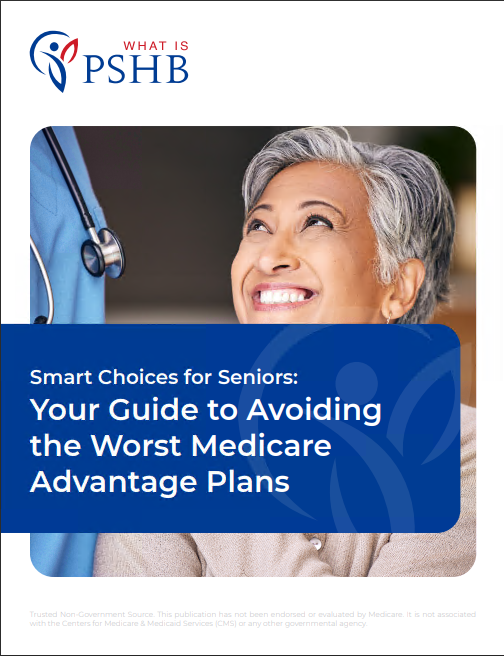Key Takeaways
-
The new $2,000 annual out-of-pocket cap for Medicare Part D in 2025 can be a game-changer, but only if your PSHB plan integrates properly with Medicare.
-
If your PSHB plan doesn’t coordinate well with Medicare Part D’s structure, you might miss out on the very protections this cap was designed to provide.
What the $2,000 Drug Cap Really Means in 2025
The 2025 Medicare Part D changes bring a long-awaited reform: an annual $2,000 cap on out-of-pocket costs for covered prescription drugs. This cap replaces the previous catastrophic phase structure and eliminates the infamous “donut hole.”
Here’s what the new structure looks like:
-
Deductible phase: You pay the full cost of your prescriptions until you meet your plan’s deductible (maximum $590).
-
Initial coverage phase: After meeting the deductible, you share costs with your plan (typically 25%) until total spending reaches the $2,000 cap.
-
Once the $2,000 cap is hit: Your plan pays 100% of covered drug costs for the rest of the year.
But here’s the catch: this benefit only applies to plans that are part of Medicare Part D. If your PSHB plan doesn’t align with a Medicare Part D Employer Group Waiver Plan (EGWP), you may not actually receive these protections.
How PSHB Prescription Drug Coverage Is Set Up
The Postal Service Health Benefits (PSHB) program includes integrated prescription drug coverage for Medicare-eligible enrollees. If you are eligible for Medicare and enroll in Part B, you are automatically enrolled in a Medicare Part D EGWP through your PSHB plan. This EGWP includes:
-
Automatic Medicare coordination
-
The $2,000 out-of-pocket cap in 2025
-
Access to expanded pharmacy networks
-
Waived deductibles or reduced cost-sharing in many plans
However, if you opt out of Medicare Part B, you also lose the EGWP drug benefit and revert to the plan’s standard non-Medicare prescription drug coverage. This standard coverage may not include the $2,000 cap, and your annual drug costs could be significantly higher.
Why Medicare Part B Enrollment Is the Gateway
For the PSHB program, enrolling in Medicare Part B isn’t just about medical coverage. It’s the ticket to accessing the Part D EGWP drug benefit. The PSHB structure in 2025 requires Medicare-eligible annuitants and family members to enroll in Part B to remain in a PSHB plan—unless they qualify for an exemption.
Without Part B:
-
You forfeit the EGWP drug coverage.
-
You remain on the non-integrated drug coverage track.
-
The $2,000 cap may not apply to your prescriptions.
Enrolling in Part B allows your PSHB plan to coordinate with both Part A and Part D, delivering the full benefits package, including access to the out-of-pocket maximum.
What Happens If You Opt Out
Some postal retirees consider opting out of Medicare Part B to avoid the monthly premium. While that saves money upfront, it can create larger financial burdens later—particularly when it comes to prescriptions.
-
Higher drug costs: If your plan doesn’t integrate with Medicare Part D, you pay the full out-of-pocket costs without reaching the $2,000 cap.
-
Loss of coordination: You lose the streamlined coordination between Medicare and PSHB, making it harder to track spending and benefits.
-
Limited re-enrollment: If you opt out of the EGWP, you may not be able to rejoin it unless you experience a qualifying life event or wait until the next Open Season.
In short, skipping Part B (and by extension, Part D) could keep you outside the very system designed to help you manage drug costs more effectively.
The Timeline You Need to Know
The out-of-pocket drug cap is in effect starting January 1, 2025. Here’s what you should track to ensure your plan is working with it:
-
January: If you’re already enrolled in a PSHB plan and Medicare Part B, your EGWP prescription coverage starts with the calendar year.
-
Mid-year notifications: Between June 30 and July 31, 2025, PSHB enrollees will receive a “Mid-Year Notification of Unused Supplemental Benefits.” This notice helps you see whether you’re underusing the drug benefit.
-
End of year: As the year wraps up, your drug costs stop at $2,000 out-of-pocket, after which your plan pays all remaining costs for the year.
How to Confirm Your Plan Coordinates with the Cap
To make sure you’re eligible for the new $2,000 cap, do the following:
-
Check your plan brochure: Look for language about an EGWP, Medicare Part D integration, or a $2,000 out-of-pocket limit.
-
Call your PSHB plan: Confirm whether they offer Medicare Part D coordination in 2025 and if it includes the cap.
-
Review your enrollment: Ensure you are actively enrolled in both Medicare Part B and your PSHB plan.
If you’re not sure about your current enrollment or want to confirm you’re maximizing benefits, a licensed insurance agent listed on this website can assist.
What to Watch for in Your PSHB Plan
Even within the PSHB system, there are plan-to-plan differences. Some things to check include:
-
Is the $2,000 cap automatic or optional? Some plans require you to opt into the Medicare coordination.
-
Do cost-sharing amounts reset annually? Make sure you know when your deductible and spending reset.
-
Does your plan reduce your cost-sharing further? Some PSHB plans waive deductibles or copayments for enrollees with Medicare Part B and Part D integration.
What If You’re Not Yet Medicare-Eligible?
If you’re still working or under 65 and not Medicare-eligible yet, you won’t be enrolled in the EGWP just yet. But as soon as you become Medicare-eligible and enroll in Part B, you’ll gain access to it. That means:
-
Start planning now. As you approach Medicare eligibility, consider the value of the drug cap and the potential savings it offers.
-
Watch for PSHB materials sent before your eligibility date. They will guide your next steps.
The Medicare Prescription Payment Plan (Another New Option)
Also starting in 2025, the Medicare Prescription Payment Plan allows you to spread out your drug costs across the calendar year with monthly payments, instead of paying large sums upfront at the pharmacy.
This feature is available to anyone enrolled in Medicare Part D—including those automatically enrolled via PSHB EGWP plans. You can:
-
Elect to pay your out-of-pocket costs in monthly installments
-
Better manage high upfront drug expenses
-
Keep track of how close you are to the $2,000 annual cap
Enrollment in this payment plan is optional, but it can help even if you reach the cap early in the year, as it provides financial predictability.
If You Need Help Understanding Your Coverage
PSHB plans can be complex, especially when layered with Medicare. If you’re unsure whether your plan is working in your favor, or you don’t know if you’re enrolled in all the right pieces (Part B, EGWP, etc.), you don’t need to figure it out alone.
Reach out to a licensed insurance agent listed on this website. They can:
-
Clarify your enrollment status
-
Help you understand if you’re covered under the new drug cap
-
Guide you on next steps if you’re missing out on benefits
Why the $2,000 Cap Doesn’t Help Everyone Equally
While the cap is a significant improvement, it isn’t universally helpful without proper integration. The people who benefit most are:
-
Enrolled in Medicare Part B
-
Automatically included in a PSHB EGWP plan
-
Using medications with high out-of-pocket costs
If you don’t meet these conditions, you could be left with drug costs well above the $2,000 limit and no safety net.
Make sure your plan isn’t just assuming coverage—verify it.
Use the New Rules to Your Advantage
The new Medicare Part D rules were designed to improve affordability and predictability. But to benefit from them under the PSHB umbrella, you need to be properly enrolled and aware of how your plan works.
The PSHB system gives postal retirees and workers access to a unique set of benefits. But understanding how they interact with Medicare’s new changes in 2025 is critical to getting the most out of your plan.
Make Sure You’re Protected Under the New Cap
The $2,000 drug cap in 2025 is only as helpful as your access to it. If your PSHB plan isn’t properly aligned with Medicare Part D through EGWP, you may be paying more than necessary.
Now is the time to review your current setup:
-
Are you enrolled in Medicare Part B?
-
Is your PSHB plan integrating with Medicare Part D?
-
Does your plan reflect the $2,000 cap?
If the answer to any of those is unclear, get in touch with a licensed insurance agent listed on this website. It could save you more than just money—it could save you peace of mind.






